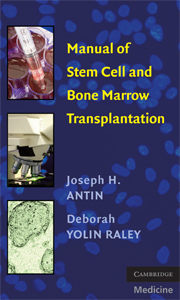Book contents
- Frontmatter
- Contents
- Acknowledgments
- Manual of Stem Cell and Bone Marrow Transplantation
- 1 Rationale for Transplantation
- 2 Types of Transplantation
- 3 HLA Matching in Allogeneic Transplantation
- 4 Stem Cell Source
- 5 Pretransplant Evaluation and Counseling of Patient and Donor
- 6 Conditioning Regimens
- 7 Stem Cell Infusion
- 8 ABO Compatibility
- 9 Engraftment
- 10 Preventative Care
- 11 Transplant-Related Complications
- 12 Graft-Versus-Host Disease – Prophylaxis and Acute
- 13 Graft-Versus-Host Disease – Chronic
- 14 Engraftment Syndrome
- 15 Infectious Disease
- 16 Graft Rejection And Failure
- 17 Gastrointestinal Complications
- 18 Pulmonary Complications
- 19 Veno-Occlusive Disease
- 20 Special Transfusion-Related Situations
- 21 Cardiovascular Complications
- 22 Neurologic Complications
- 23 Cystitis
- 24 Donor Lymphocyte Infusion
- 25 Transplantation: Regulation And Accreditation
- Appendix
- Index
1 - Rationale for Transplantation
Published online by Cambridge University Press: 23 November 2009
- Frontmatter
- Contents
- Acknowledgments
- Manual of Stem Cell and Bone Marrow Transplantation
- 1 Rationale for Transplantation
- 2 Types of Transplantation
- 3 HLA Matching in Allogeneic Transplantation
- 4 Stem Cell Source
- 5 Pretransplant Evaluation and Counseling of Patient and Donor
- 6 Conditioning Regimens
- 7 Stem Cell Infusion
- 8 ABO Compatibility
- 9 Engraftment
- 10 Preventative Care
- 11 Transplant-Related Complications
- 12 Graft-Versus-Host Disease – Prophylaxis and Acute
- 13 Graft-Versus-Host Disease – Chronic
- 14 Engraftment Syndrome
- 15 Infectious Disease
- 16 Graft Rejection And Failure
- 17 Gastrointestinal Complications
- 18 Pulmonary Complications
- 19 Veno-Occlusive Disease
- 20 Special Transfusion-Related Situations
- 21 Cardiovascular Complications
- 22 Neurologic Complications
- 23 Cystitis
- 24 Donor Lymphocyte Infusion
- 25 Transplantation: Regulation And Accreditation
- Appendix
- Index
Summary
Hematopoietic stem cell transplantation (HSCT) has the potential to cure a variety of benign and hematologic diseases that may be incurable with conventional therapy. In its broadest form, HSCT consists of three parts: a conditioning phase, stem cell infusion, and for allogeneic procedures, a method for prophylaxis of graft-versus-host disease (GVHD). There are, however, many variations of this framework. Conditioning regimens include various combinations of chemotherapy, radiotherapy, and immunotherapeutic agents. All conditioning regimens must produce at least enough immunosuppression to prevent graft rejection; beyond this, they can vary considerably in intensity, ranging from high dose regimens that result in complete ablation of the patient's bone marrow to reduced intensity regimens that cause only mild myelosuppression. Stem cells can be obtained from bone marrow (BM), peripheral blood (PB), or umbilical cord blood (UCB). Finally, GVHD prophylaxis can be achieved through immunosuppressive medications or graft manipulation (in particular T-cell depletion). The choice of conditioning regimen, stem cell source, and GVHD prophylaxis regimens varies on the basis of patient and disease characteristics as well as donor availability. In the case of allogeneic HSCT for hematologic malignancies, one of the principal goals is to allow engraftment and development of a donor-derived immune system, that can effect an immunologic attack against the recipient lymphohematopoietic system, and in particular against the tumor cells. This graft-versus-tumor (GVT) effect is a fundamental and unique aspect of allogeneic HSCT.
- Type
- Chapter
- Information
- Publisher: Cambridge University PressPrint publication year: 2009



